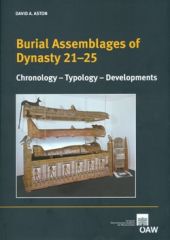
Burial Assemblages of Dynasty 21-25, pp. 417-424, 2010/06/16
Chronology – Typology – Developments
This study is an investigation of funerary assemblages of the Third Intermediate Period (1070–664 BC) with a view to dating the objects of which these assemblages are composed more accurately than hitherto. This is done by providing a corpus of all published Third Intermediate Period tomb groups, and extracting from it a number of object typologies for individual grave goods with a view to assessing their value as a means of dating the tomb groups in which they are found. These typologies are then combined to chart a series of chronological developments throughout the period here under review. The first three chapters are devoted to discussions of the tomb groups arranged in geographical order; Chapter One dealing with the tombs found in the Delta, which includes the royal tombs at Tanis, where, surprisingly, for the first time, all the objects are listed with their museum numbers. Chapter Two deals with the tombs found in the Nile Valley, listed from north to south, whilst a separate chapter, Chapter Three, is devoted entirely to Thebes. Chapter Four discusses various types of grave goods, providing a synthesis of typological and chronological developments of bead nets, Canopic jars, Canopic chests, Canopic coffins, Osiris and Ptah-Sokar-Osiris figures, pottery, wooden stelae, ushabtis, shabti jars and shabti boxes. Additionally various other groups of objects – amulets, artificial eyes, baskets, corn mummies, faience vessels, fans, fishing nets, food offerings, inscribed bricks, ivory objects, jewellery, leather objects, linen articles, metal objects, pets, scarabs, shells, shoes and sandals, statue fragments, stone vessels, temple fragments, wigs and hairpins, whips, wooden objects and wreaths, are all described. In a concluding chapter, demographic, social and regional differences are discussed enabling the author to postulate six successive chronological phases for the elite burials at Thebes. An appendix on tomb architecture of the time, a comprehensive literature list and an all-inclusive index of museum numbers is also provided.
…
Diese Arbeit versteht sich als Untersuchung von Grabbeigaben der Dritten Zwischenzeit (1070–664 vor Chr.) mit dem Ziel, solche Funde akkurater als bisher datieren zu können. Dies wird durch die Zusammenstellung eines Korpus aller bis dato publizierten Fundgruppen aus Gräbern der Dritten Zwischenzeit erreicht, aus denen verschiedene Objektkategorien von Grabbeigaben herausgegriffen und in Form von Typologien auf ihre chronologische Verwertbarkeit untersucht werden, um dadurch ihrerseits jene Gräber genauer zu datieren, in denen sie gefunden wurden. Diese Typologien wurden schließlich kombiniert, um chronologische Entwicklungen der Dritten Zwischenzeit nachzuzeichnen. Die ersten drei Kapitel beschäftigen sich mit der Untersuchung der Fundgruppen der Gräber der Dritten Zwischenzeit in geographischer Anordnung. Ein Appendix bietet einen Überblick über die Grabarchitektur der Dritten Zwischenzeit, eine umfassende Bibliographie und einen ausgedehnten Index der Funde mit ihren Museumsnummern.